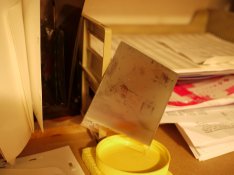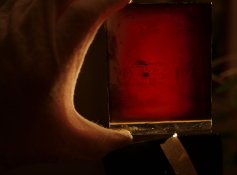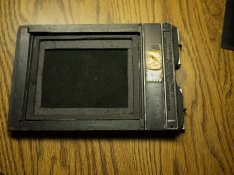holmburgers
Member
Thanks PE... I was way off.
 ). The question is, are they suitably panchromatic?
). The question is, are they suitably panchromatic?Now, the thing that has me wondering is whether or not you can just leave the emulsion on the mirror during processing & for viewing. There seems to be some disagreement, or at least a lack of clear concensus on this.
J.S. Friedman in the History of Color Photography clearly states that the mirror must be present for viewing, and that this is of course difficult with mercury.
However, Struan's post puts us back in contradiction; saying that the reflector will strengthen the effect.
Can the reflector remain for viewing or not? :confused: that is the question
I have not made or seen Lippmann emulsions, but I am a physicist. You don't need a metallic mirror to get a strong reflection (jewel beetles and morpho butterflies do very well with lamellae of chitin and air). However, the silver lamellae in a Lippmann emulsion are created with a metallic reflecting surface on the back of the emulsion, and it seems clear that reproducing that metallic coating will maximise the wavelength-specific reflection when viewing. The phase shift when light reflects off the back of the emulsion will be the same with or without a metallic layer, but the strength and wavelength dependence will certainly be different.
An aluminium front surface mirror will be clouded and/or etched by quite weak solutions of either acid or alkali.(...)
Al ion in solution also interfere with the balance of Ag redox reactions. Most darkroom books advise against using Al trays for this reason. I'm not enough of a darkroom chemist to say how bad the effects are, but the warning makes sense to me.
However, the silver lamellae in a Lippmann emulsion are created with a metallic reflecting surface on the back of the emulsion (...).









Here's a theoretical proposition... is there another liquid that would be easier to work with than mercury and more reflective than no mirror whatsoever?
For instance, would there be an advantage in using water as opposed to no reflector at all. In the reflector-less, Bjelkhagen method (we'll call it), the reflection comes from the emulsion-air interface, correct?
Here are several views of my 1st Lippmann plate, or at least an attempt at it. It's from the same batch of plates that R Shaffer used and by the way Rob, did we ever figure out what the actual emulsion


One reason the interference in a Lippmann plate is weak is that your light is incoherent. A laser can fill a thick emulsion with fringes, but incoherent light does much worse, even if it is filtered to be monochromatic. A rough rule of thumb for thermal light (black body radiation, aka sunlight) is that the coherence length is of the order of the centre wavelength. In layman's terms that means you can only expect to get two or three fringes. It's one reason why Lippmann emulsions are thin: there is no benefit to a thicker emulsion, it just wastes silver and absorbs and scatters light.
FWIW, the Morpho butterfly scales are 3D on the nanoscale. The remarkable thing about the Morphos is not that they have lovely colours, but that their colour is so strong, and so pure, over a wide range of angles and lighting conditions. If you could somehow reproduce their method of generating colour, and vary it across a substrate, you would be a very happy camper indeed.
| Photrio.com contains affiliate links to products. We may receive a commission for purchases made through these links. To read our full affiliate disclosure statement please click Here. |
PHOTRIO PARTNERS EQUALLY FUNDING OUR COMMUNITY:  |